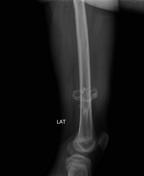Osteochondroma
Diagnosis certain
Updates to Quizquestion Attributes
Question
was changed:
What are the possible complications?
Updates to Quizquestion Attributes
Answer
was changed:
Updates to Case Attributes
Body
was changed:
This is a typical case of osteochondrmaosteochondroma, typical clinical presentation (age of patient, painless humplump), typical location (femur is the commonestmost affected bone), typical appearance (pedunculated bony outgrowth that directed away from the joint).
Osteochondromas are the most common bone tumors in children, may be solitary or multiple.
The true prevalence of solitary osteochondromas is not known, because many asymptomatic lesions go undiagnosed.
A painless skeletal swelling or a slowly growing mass is the usual mode of presentation.
Most osteochondromas, solitary or multiple, arise from tubular bones and are metaphyseal in location.
-<p>This is a typical case of osteochondrma, typical clinical presentation (age of patient, painless hump), typical location (femur is the commonest affected bone), typical appearance (pedunculated bony outgrowth that directed away from the joint).</p><p>Osteochondromas are the most common bone tumors in children, may be solitary or multiple.</p><p>The true prevalence of solitary osteochondromas is not known, because many asymptomatic lesions go undiagnosed. </p><p>A painless skeletal swelling or a slowly growing mass is the usual mode of presentation. </p><p>Most osteochondromas, solitary or multiple, arise from tubular bones and are metaphyseal in location.</p>- +<p>This is a typical case of osteochondroma, typical clinical presentation (age of patient, painless lump), typical location (femur is the most affected bone), typical appearance (pedunculated bony outgrowth that directed away from the joint).</p><p>Osteochondromas are the most common bone tumors in children, may be solitary or multiple. The true prevalence of solitary osteochondromas is not known, because many asymptomatic lesions go undiagnosed. A painless skeletal swelling or a slowly growing mass is the usual mode of presentation. </p><p>Most osteochondromas, solitary or multiple, arise from tubular bones and are metaphyseal in location.</p>
Presentation
was changed:
Painless humplump on the left lower thigh.
Diagnostic Certainty
was set to
.
Systems changed:
- Paediatrics
Updates to Study Attributes
Images Changes:
Image X-ray (Frontal) ( update )

Description
was removed:
Single Or Stack Root
was set to
.
Image X-ray (Lateral) ( update )

Description
was removed:
Single Or Stack Root
was set to
.